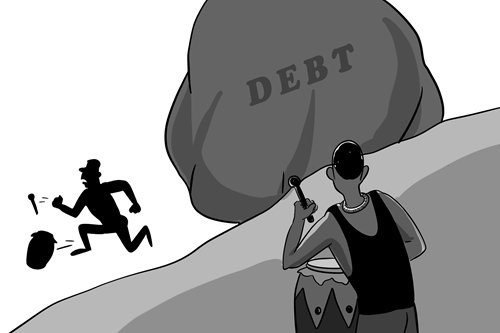Uncovering the truth behind Africa's debt woes

Illustration(GT/Luo Xuan)
Western countries continue to use China's Belt and Road Initiative (BRI) as a scapegoat for Africa's debt woes, claiming the initiative is nothing more than a "debt trap." However, debt risk in Africa has been a long-standing problem. The recent debt increases are mainly due to the financial crisis and its ripple effects. Now could be the ideal opportunity for Africa to curb added debt risks.
The ongoing debt issue, especially in sub-Saharan Africa, has been exaggerated. Average public debt in the region was 57 percent of its GDP by the end of 2017. Those who suspect a debt crisis apparently did not place the rich and poor countries on an equal footing since the US had a general government debt to GDP ratio of over 100 percent, while Japan's was over 200 percent in the same year.
The financial crisis of 2008-09 is what caused Africa's debt problems. Poor economic performance accelerated debt accumulation. In 2014, just as the BRI was taking shape, The Economist already discussed a potential debt crisis in Africa that featured a graph showing the debt that was owed to official creditors had been in decline in 2005-06, but started to rise after the financial crisis.
Another reason for the increased debt is related to oil prices, which took a hit in 2008. African countries have different situations as they either have sufficient or deficient resources and are sensitive to international energy prices. Some African countries such as Angola, Libya, and Nigeria are OPEC members. Meanwhile, over half of all African countries are net importers.
The decline in oil prices during the latter part of 2008 increased debt and damaged producer economies. The bounced energy prices also hurt African nations short of resources.
Structural debt changes should also be considered. More private lenders driven by profit, rather than official creditors, were attracted to the African countries due to the low interest rates major economies adopted following the financial crisis.
Official creditors offer concessional loans. The Multilateral Debt Relief Initiative and Heavily Indebted Poor Countries Initiative wrote off qualified debt for African countries. The loans provided by countries like China are usually concessional loans with lower interest rates or extended terms. A total of $15 billion out of $60 billion in support to Africa announced last year by China arrived in the form of aid, along with interest-free and concessional loans.
Chinese loans are devoted to local infrastructure development. Kenyan President Uhuru Kenyatta rejected the idea that loans from China create so-called "debt traps." During an interview from last year, Kenyatta said Kenya borrowed from China to close the infrastructure gap rather than allow debt for current expenditure accounts to cover salaries and electricity bills.
The "Angola model," also criticized by Western countries, actually worked. China offered cheap credit rates to Angola, which then used its oil as collateral. With this model, Africa's second largest oil producer managed to build infrastructure such as roads and houses.
BRI projects can safeguard African countries with vulnerable economies from global economic crises and international resource price fluctuations. The China-built Ethiopia-Djibouti railway opened for commercial operations on the first day of 2018, and the largest free trade zones in Djibouti, mainly founded by Chinese companies, began operations in 2017. Djibouti, a country with scarce resources, was able to achieve over 6.5 percent annual GDP growth since 2016 in spite of resource price fluctuations.
As the world economy recovers from the last financial crisis, now might be a good time for African countries to address potential debt risks looming in the background.
African policymakers could make their debt policies more consistent. In countries where the leadership changes, debt policies are often reevaluated. Sierra Leone canceled a $300 million airport project with China because the new government felt it wasn't "economical."
Another issue with African debt is how loan maturity is too short to cover infrastructure expenses. More long-term bonds need to be issued.
What it really boils down to is that African nations need to improve their internal financial systems, mobilize resources, and develop better tax collecting methods.
(The author is a senior research fellow at the Institute of West Asian and African Studies at the Chinese Academy of Social Sciences and a senior research fellow at the Charhar Institute.)


